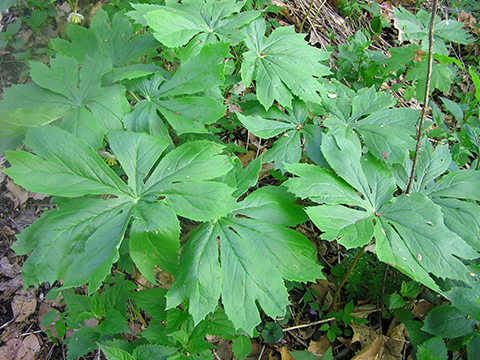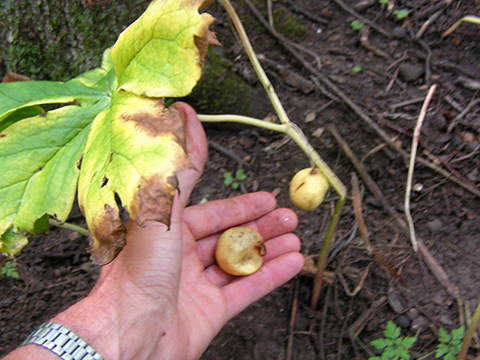 |
| Home | Ordering By Mail | Purchase Manual: Using Native Plants in Urban Landscapes |
|
|||||
Species Name: Podophyllum peltatum
Common Name: Mayapple
Zone: 3 to 9
Distribution: Quebec and Maine south to Florida and Texas.
Seed collection: A single flower is produced in the fork of double leaved plants. Only mature stems bear double leaves all immature stems have just a single leaf. From the single flower develops a plum sized fruit resembling a miniature apple, hence the common name. When mature in late August or early September the fruit changes from green to a creamy-yellow color and the flesh softens. Each fruit may contain up to a dozen seeds held in the soft pulp.
Seed handling: Harvest the fruit when it begins to change color. Let the fruit ripen and then macerate by hand or use a food processor. Wash away the pulp leaving the seed behind. Begin to moist stratify the seed shortly after cleaning do not let the seed dry out for very long as viability will decrease.
Germination requirements: The majority of stratified seed will germinate the first spring after planting. The first true leaf looks like a small version of the mature leaves. The primary leaf will continue to enlarge and as the rhizome stores food reserves the plant will send out additional stems.
As Mayapple is highly rhizomatous it is easy to dig up, cut into sections and transplant sections of root in early spring to establish new plants and new colonies. Transplanting can also be done in the fall after the leaves have senesced.
Ecology: Mayapple is rhizomatous and spreads clonally from the fleshy underground root system the lies just below the soil surface. Numerous, single stemmed, large broad leaves emerge along the roots forming a spreading ground cover. When enough energy has been stored in the rhizome a forked double leafed stem will emerge that will bear a single flower in the fork where the two leaves are joined.
Mayapple prefers moist cool soils for best growth. If the summer is dry and soil moisture insufficient to sustain plant growth the leaves will naturally senesce and the plant will prematurely go dormant. When this occurs any remaining fruit and any potential seed will be aborted for that season.
Mayapple forms large clonal colonies in any rich woodland soil. It will spread indefinitely from the root system one to two foot per year. As the flowers are self-incompatible, few fruit are produced and little sexual reproduction takes place so most of the large patches of Mayapple are all from the same clonal rootstock.
Mayapple’s broad spreading leaves and dense branching rhizome form an effective barrier to other herbaceous plants getting established where Mayapple is well established.
Mayapple is also fairly deer resistant and will persist where deer populations are high.

Colony of Mayapple plants

Mayapple fruit ripe and ready for picking. Only forked stems with double leaves produce flowers and fruit.
Each fruit contains up to a dozen brown seeds.
this page posted January 6th, 2014